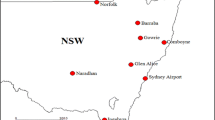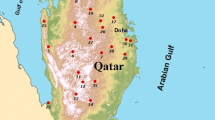Abstract
Design rainfall is frequently utilized in the planning and design of urban infrastructure, including culverts and urban drainage systems. The choice of an appropriate probability distribution that sufficiently fits the observed rainfall data is one of the key elements in designing rainfall estimation. The current study compared five probability distribution methods which include Gumbel, log-Normal, Normal, Pearson III, and log-Pearson III probability distribution method (PDMs) to analyze the rainfall pattern of the study area. The goodness of fit of the PDMs was also tested by determining the root mean square error (RMSE) scores of PDMs results. Three spatial distribution modelling methods which include inverse distance weighting (IDW), universal kriging (UK), and ordinary kriging (OK) were used to spatially distribute and compare the resulting rainfall pattern from the five PDMs. The findings of the study revealed that the log-Pearson III probability distribution method (PDM) was very outstanding among the five PDMs used in analyzing the rainfall pattern design of the study area. The LPII also showed the lowest root mean square error (RMSE) value. Furthermore, the IDW presented a clearer and more accurate representation of the rainfall design and average annual rainfall of the study area by showing the method with the least RMSE value in comparison to the OK and UK which slightly underestimated and overestimated their prediction results. The result of this study can be applied to effective early warning systems for future rainfall prediction and accurate design of water resource structures for a sustainable environment.






Similar content being viewed by others
Data availability
The authors will make available the data associated with this research on request through the corresponding author.
References
Ahmed R, Ali S (2016) Modelling of intensity-duration-frequency curves for Lahore City using frequency analysis. Sustain Dev Plan VIII 1:725–733. https://doi.org/10.2495/sdp160611
Ahuchaogu II, Ewemoje TA, Etim I (2019) Best Probability Distribution for Rainfall Analysis suited for University of Uyo, Ikpa watershed of Akwa Ibom State, Nigeria. Int J Eng Res V8:556–565. https://doi.org/10.17577/ijertv8is090133
Alam MA, Emura K, Farnham C, Yuan J (2018) Best-fit probability distributions and return periods for maximum monthly rainfall in Bangladesh. Climate. https://doi.org/10.3390/cli6010009
Amin MT, Izwan M, Alazba AA (2016) A best-fit probability distribution for the estimation of rainfall in northern regions of Pakistan. Open Life Sci 11:432–440. https://doi.org/10.1515/biol-2016-0057
Azeez B, Ayoola FJ (2012) Fitting the statistical distribution for daily rainfall in Ibadan, based on chi-square and Kolmogorov- Smirnov goodness-of-fit tests. Eur J Bus Manag 4:62–70
Bhakar S, Kumar Bansal A, Bhakar SR, Iqbal M, Devanda M, Chhajed N, Bansal AK (2014) Probability analysis of rainfall at Kota. Indian J Agric Res 42(3):201–206
Ewea HA, Elfeki AM, Al-Amri NS (2017) Development of intensity–duration–frequency curves for the Kingdom of Saudi Arabia. Geomat Nat Hazards Risk 8:570–584. https://doi.org/10.1080/19475705.2016.1250113
Gado TA, Salama AM, Zeidan BA (2021) Selection of the best probability models for daily annual maximum rainfalls in Egypt. Theor Appl Climatol 144:1267–1284. https://doi.org/10.1007/s00704-021-03594-0
Griffis VW, Stedinger JR (2007) log-Pearson type 3 distribution and its application in flood frequency analysis II : parameter estimation methods. J Hydrol Eng 12(5):492–500
Kim J, Shu E, Lai K, Amodeo M, Porter J, Kearns E (2022) Assessment of the standard precipitation frequency estimates in the United States. J Hydrol Reg Stud 44:101276. https://doi.org/10.1016/j.ejrh.2022.101276
Kubota T, Ahmad S (2006) Wind environment evaluation of neighborhood areas in major towns of Malaysia. J Asian Archit Build Eng 5:199–206. https://doi.org/10.3130/jaabe.5.199
Kumar M, Shekhar C, Manocha V (2021) Maximum rainfall probability distribution pattern in Haryan—A case study. J Appl Nat Sci 8(4):2029–2036
Mamoon AA, Rahman A (2017) Selection of the best fit probability distribution in rainfall frequency analysis for Qatar. Nat Hazards 86:281–296. https://doi.org/10.1007/s11069-016-2687-0
Mandeep JS, Hassan SIS, Tanaka K (2008) Rainfall measurements at Ku-band satellite link in Penang, Malaysia. IET Microw Antennas Propag 2:147–151. https://doi.org/10.1049/iet-map
Mandeep JS, Nalinggam R, Ismai W (2011) Cumulative distribution of rainfall data for tropical countries. Sci Res Essays 6:447–452. https://doi.org/10.5897/SRE10.971
Markovic RD (1965) Probability functions of best fit to distributions of annual precipitation and runoff. Hydrol Pap 8:39
Mukhtar HB (2012) Spatial and temporal rainfall pattern in Pulau Pinang. School of Civil Engineering, Universiti Sains Malaysia
Nguyen V, Wang H (1996) Regional estimation of short-duration rainfall distribution using available daily rainfall data. J Water Manag Model R191:179–186. https://doi.org/10.14796/JWMM.Rl91-ll
Parmar P, Mayoor M, Singh HP (2022) Probabilistic analysis of annual time series of precipitation stochastic modeling & applications
Rao AR, Hamed KH (2000) Flood frequency analysis. CRC Press, pp 1–350
Rochyani N (2017) Study of acid mine drainage management with evaluating climate and rainfall in east pit 3 West Banko coal mine. AIP Conf Proc. https://doi.org/10.1063/1.5011525
Salarpour M, Yusop Z, Yusof F (2012) Modelling the distribution of flood characteristics for a tropical river basin. J Environ Sci Technol 5:419–429
Sharma MA, Singh JB (2010) Use of probability distribution in rainfall analysis. New York Sci J 3:40–49
Singh VP (1998) log-Pearson type III distribution. Springer, Dordrecht, pp 252–274. https://doi.org/10.1007/978-94-017-1431-0_15
Sreedhar BR (2019) Fitting of probability distribution for analyzing the rainfall data in the state of Andhra Pradesh, India. Int J Appl Eng Res 14:835–839
Tao DQ, Nguyen VTV, Bourque A (2002) On selection of probability distributions for representing extreme precipitations in Southern Quebec. Proceedings, Annu Conf - Can Soc Civ Eng. pp. 257–264
Tegegn F, Mojira T, Corporation ES (2022) The impact of rainfall -runoff on the performance of main irrigation canal and cross drainage of Omo-Kuraz I and II sugar project (The case of Omo-Gibe Basin). Civil Environ Res. https://doi.org/10.7176/CER/14-2-02
Upadhyaya A, Singh SR (1998) Estimation of consecutive days maximum rainfall by various methods and their comparison. Indian J Soil Conserv 26:193–201
Vivekanandan N (2015) Flood frequency analysis using method of moments and L-moments of probability distributions. Cogent Eng. https://doi.org/10.1080/23311916.2015.1018704
Wang S, Huang GH, Lin QG, Li Z, Zhang H, Fan YR (2014) Comparison of interpolation methods for estimating spatial distribution of precipitation in Ontario, Canada. Int J Climatol 34:3745–3751. https://doi.org/10.1002/joc.3941
Ximenes PSMP, Alves da Silva AS, Ashkar F, Stosic T (2021) Best-fit probability distribution models for monthly rainfall of Northeastern Brazil. Water Sci Technol 84:1541–1556. https://doi.org/10.2166/wst.2021.304
Funding
The authors did not receive any funding for this research.
Author information
Authors and Affiliations
Contributions
RBM: investigation, conceptualization, methodology, writing—original draft, software, formal analysis, visualization, validation, writing—review and editing. NS: supervision, project administration, writing—review and editing. HBM: conceptualization, and methodology. WOB: software and resources.
Corresponding authors
Ethics declarations
Conflict of interest
The authors declare that they have no known competing financial interests or personal relationships that could have appeared to influence the work reported in this paper.
Additional information
Publisher's Note
Springer Nature remains neutral with regard to jurisdictional claims in published maps and institutional affiliations.
Rights and permissions
Springer Nature or its licensor (e.g. a society or other partner) holds exclusive rights to this article under a publishing agreement with the author(s) or other rightsholder(s); author self-archiving of the accepted manuscript version of this article is solely governed by the terms of such publishing agreement and applicable law.
About this article
Cite this article
Mudashiru, R.B., Abustan, I., Sabtu, N. et al. Choosing the best fit probability distribution in rainfall design analysis for Pulau Pinang, Malaysia. Model. Earth Syst. Environ. 9, 3217–3227 (2023). https://doi.org/10.1007/s40808-022-01668-0
Received:
Accepted:
Published:
Issue Date:
DOI: https://doi.org/10.1007/s40808-022-01668-0




